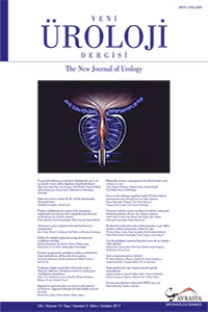Gleason skor 6 prostat kanserinin ekstraprostatik yayılımı: tek merkez deneyimi
Prostat Kanseri, Gleason Skor, Ekstraprostatik Yayılım
Extraprostatic extension of gleason 6 prostate cancer: single center experience
Prostate Cancer, Gleason Score, Extraprostatic Extension,
___
- 1. Ferlay J, Soerjomataram I, Dikshit R, et al. Cancer incidence and mortality worldwide: sources, methods and major patterns in GLOBOCAN 2012. International journal of cancer. 2015;136(5):359-86.
- 2. Pernar CH, Ebot EM, Wilson KM, Mucci LA. The epidemiology of prostate cancer. Cold Spring Harbor Perspectives in Medicine. 2018;8(12):a030361.
- 3. Yilmaz B, Sarikaya D. Prostat Kanseri İnsidansı ve Risk Faktörleri. Türkiye Klinikleri Tıbbi Onkoloji-Özel Konular. 2017;10(4):337-42.
- 4. Mohler JL, Armstrong AJ, Bahnson RR, et al. Prostate cancer, version 3.2012 featured updates to the NCCN guidelines. Journal of the National Comprehensive Cancer Network. 2012;10(9):1081-7.
- 5. Rubio-Briones J, Borque A, Esteban L, et al. Preliminary results of the Spanish Association of Urology National Registry in Active Surveillance for prostate cancer. Actas Urológicas Españolas (English Edition). 2016;40(1):3-10.
- 6. Samaratunga H, Delahunt B, Egevad L, Srigley JR, Yaxley J. The evolution of Gleason grading of prostate cancer. J Diagn Pathol. 2017;12:5-11.
- 7. Liu J-J, Lichtensztajn DY, Gomez SL, et al. Nationwide prevalence of lymph node metastases in Gleason score 3+ 3= 6 prostate cancer. Pathology. 2014;46(4):306-10.
- 8. Epstein JI, Egevad L, Amin MB, Delahunt B, Srigley JR, Humphrey PA. The 2014 International Society of Urological Pathology (ISUP) consensus conference on Gleason grading of prostatic carcinoma. The American journal of surgical pathology. 2016;40(2):244-52.
- 9. Mohler j, Bahnson RR, Boston B, et al. NCCN clinical practice guidelines in oncology: prostate cancer. Practice Guideline J Natl Compr Canc Netw. 2010 Feb;8(2):162-200.
- 10. Hamilton AS, Albertsen PC, Johnson TK, et al. Trends in the treatment of localized prostate cancer using supplemented cancer registry data. BJU international. 2011;107(4):576-84.
- 11. Carter HB, Partin AW, Walsh PC, et al. Gleason score 6 adenocarcinoma: should it be labeled as cancer? Journal of Clinical Oncology. 2012;30(35):4294.
- 12. Hernandez DJ, Nielsen ME, Han M, et al. Natural history of pathologically organ-confined (pT2), Gleason score 6 or less, prostate cancer after radical prostatectomy. Urology. 2008;72(1):172-6.
- 13. Anderson BB, Oberlin DT, Razmaria AA, et al. Extraprostatic extension is extremely rare for contemporary Gleason score 6 prostate cancer. European Urology. 2017;72(3):455-60. 14. Hassan O, Han M, Zhou A, et al. Incidence of extraprostatic extension at radical prostatectomy with pure Gleason score 3+ 3= 6 (grade group 1) cancer: Implications for whether Gleason score 6 prostate cancer should be renamed" not cancer" and for selection criteria for active surveillance. The Journal of urology. 2018;199(6):1482-7.
- 15. Takamatsu K, Matsumoto K, Shojo K, et al., editors. The prognostic value of zonal origin and extraprostatic extension of prostate cancer for biochemical recurrence after radical prostatectomy. Urologic Oncology: Seminars and Original Investigations; 2019: Elsevier.
- 16. Farchoukh L, Laframboise WA, Nelson JB, Bastacky S, Parwani AV, Dhir R. Multifocal Extraprostatic Extension of Prostate Cancer: A Third Subtype With Worse Prognosis Than Focal Prostate Cancer. American Journal of Clinical Pathology. 2020;153(4):548-53.
- 17. Maubon T, Branger N, Bastide C, et al. Impact of the extent of extraprostatic extension defined by Epstein’s method in patients with negative surgical margins and negative lymph node invasion. Prostate Cancer and Prostatic Diseases. 2016;19(3):317-21.
- 18. Ball MW, Partin AW, Epstein JI. Extent of extraprostatic extension independently influences biochemical recurrence-free survival: evidence for further pT3 subclassification. Urology. 2015;85(1):161-4.
- ISSN: 1305-2489
- Yayın Aralığı: 3
- Başlangıç: 2005
- Yayıncı: Pera Yayıncılık
Eser Ordek, Mehmet Kolu, Mehmet Demir, Eyyup Sabri Pelit, Halil Ciftci
Laparoskopik donör nefrektomi sonrasında silöz asit: Türkiye’deki ilk olgu sunumu
Selcuk Sahin, Osman Ozdemir, Ismail Evren, Serdar Karadag, Volkan Tugcu, Ali Ihsan Tasci
Renal kitle perkütan biyopsi sonuçlarımızın retrospektif incelenmesi
Ilyas Dundar, Fatma Durmaz, Sercan Ozkacmaz, Nazim Abdulkadir Kankilic, Abdullah Gul, Mesut Ozgokce
Manyetik rezonans görüntüleme-ultrason füzyon prostat biyopsisi tek merkez sonuçları
Sercan Yilmaz, Halil Cagri Aybal, Hakan Ozdemir, Eymen Gazel, Engin Kaya, Serdar Yalcin, Mehmet Yilmaz, Ali Yusuf Oner, Mehmet Yorubulut, Lutfi Tunc
Üriner sistemin nefrojenik adenomları: 30 vakanın klinikopatolojik analizi
Berna Aytac Vuruskan, Ezgi Isil Turhan, Hakan Vuruskan, Ismet Yavascaoglu
Mert Kilic, Meftun Culpan, Asif Yildirim, Turhan Caskurlu
Türk popülasyonunda oligozoospermi ve azospermi hastalarında infertilitenin genetik nedenleri
Yavuz Onur Danacioglu, Mustafa Gurkan Yenice, Fatih Akkas, Mustafa Soytas, Serhat Seyhan, Ali Ihsan Tasci
Kubra Ozgok Kangal, Kubra Canarslan Demir
COVID-19 pandemisinin ürolojik konsültasyonlara ve ürolojik cerrahiye akut etkisi
Mehmet Caglar Cakici, Ayberk Iplikci, Ozgur Efiloglu, Gokhan Atis, Asif Yildirim
Sezgin Okcelik, Halil Kizilöz, Niyazi Ozgur Kurul, Cumhur Yesildal, Muhammed Cihan Temel
